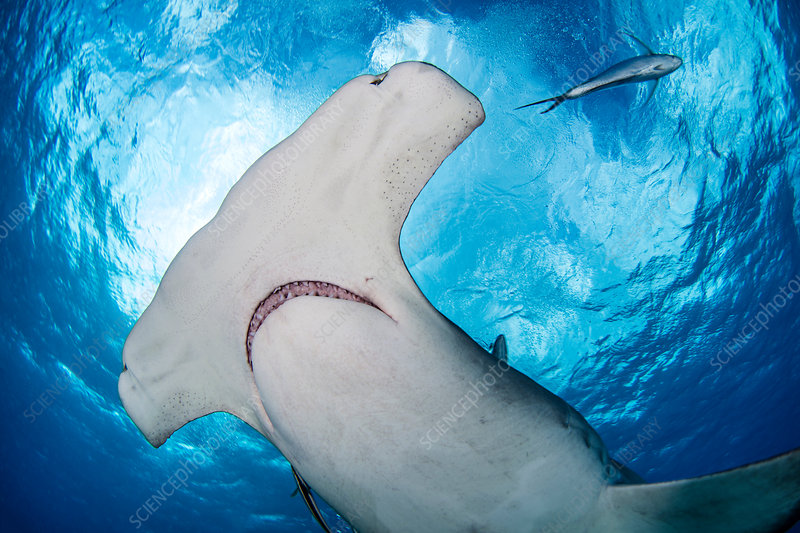ANIMAL: Great Hammerhead Sphyrna mokarran Type of Animal: Hammerhead Shark Habitat: Tropical/subtropical/temperate waters, preferring warmer temps: Coastal areas, open ocean, continental shelves, coastlines, semi-oceanic areas, lagoons to 262 ft deep, island terraces, deep water near land, coral reefs, coastal-pelagic areas, found in depths as deep as 984 ft deep, estuaries, intertidal waters, rocky reefs, kelp forest, sandy plains Location(s): In W Atlantic from N Carolina to Uruguay (including Gulf of Mexico & Caribbean), E Atlantic from Morocco to Angola, Mediterranean through Red Sea & rims of Indian Ocean into W Pacific as far north as S Japan, also found around New Caledonia & French Polynesia as well as Australia, in E Pacific occurs from S Baja California to Peru Appearance: Largest hammerhead species, tall sickle shape first dorsal fin, streamlined body, dark brown to light gray to olive on top, white underside Food/Diet: Rays, octopus, squid, crabs, lobsters, other sharks (including smaller members of own species), skates, tarpon, sardines, sea catfish, grunts, jacks, toadfish, porgies, groupers, flatfishes, boxfish, porcupinefish, herring, guitarfish, pinnipeds Status in Wild: Endangered Conservation: Shark finning bans in parts of range, research on migration sites Lifestyle: Solitary or small schools Additional Info: Called: Male Female Young-Pup Group-School/Shiver/Pack Weight: Male: 110-520 lbs Female: 90-1000 lbs Gestation: 11 months Life Span: 20-30 years Body Length: Male: 7.55-9.84 ft Female: 8.2-17 ft Young: 4 ft Tail Length: Male: 3.775-4.92 ft Female: 4.1-8.5 ft Young: 2 ft Main predators of adults are killer whales/orcas, tiger sharks, & great whites. Many larger sharks (including adults of own species) prey on young/juveniles/even sub-adults. These sharks viviparous w/ fertilized eggs hatching while still in uterus. This results in live birth. Endangered due to low reproductive rate (many females only reproduce every other year), overfishing for fins/meat/liver oil/hide, accidental bycatch, entanglement in nets, & water pollution. While slow breeders, females can have litters of 10-55 pups. Tend to be migratory. Sexually mature at 5-9 years old. To catch stingrays, they’ll use side of hammer shape head to pin them down. Typically hunt at dawn & dusk. Fun Fact(s): Rare in captivity due to large size & risk of injuring hammer-shaped head. These sharks potentially dangerous due to large size & sharp teeth. However, they’re not usually aggressive towards humans but can be inquisitive. Highly likely immune to stingray & catfish venom. Barbs have been seen sticking out of their mouths.
